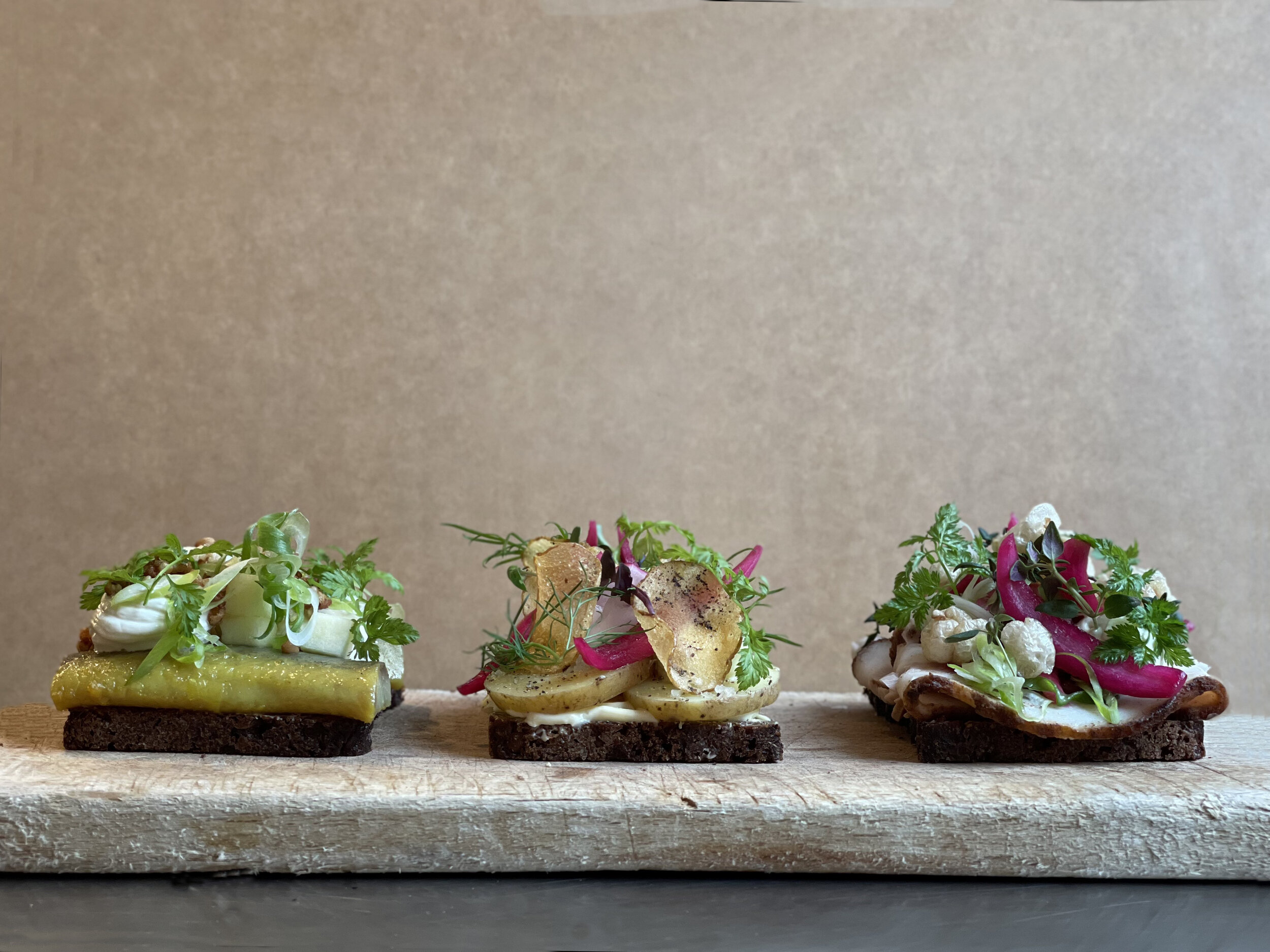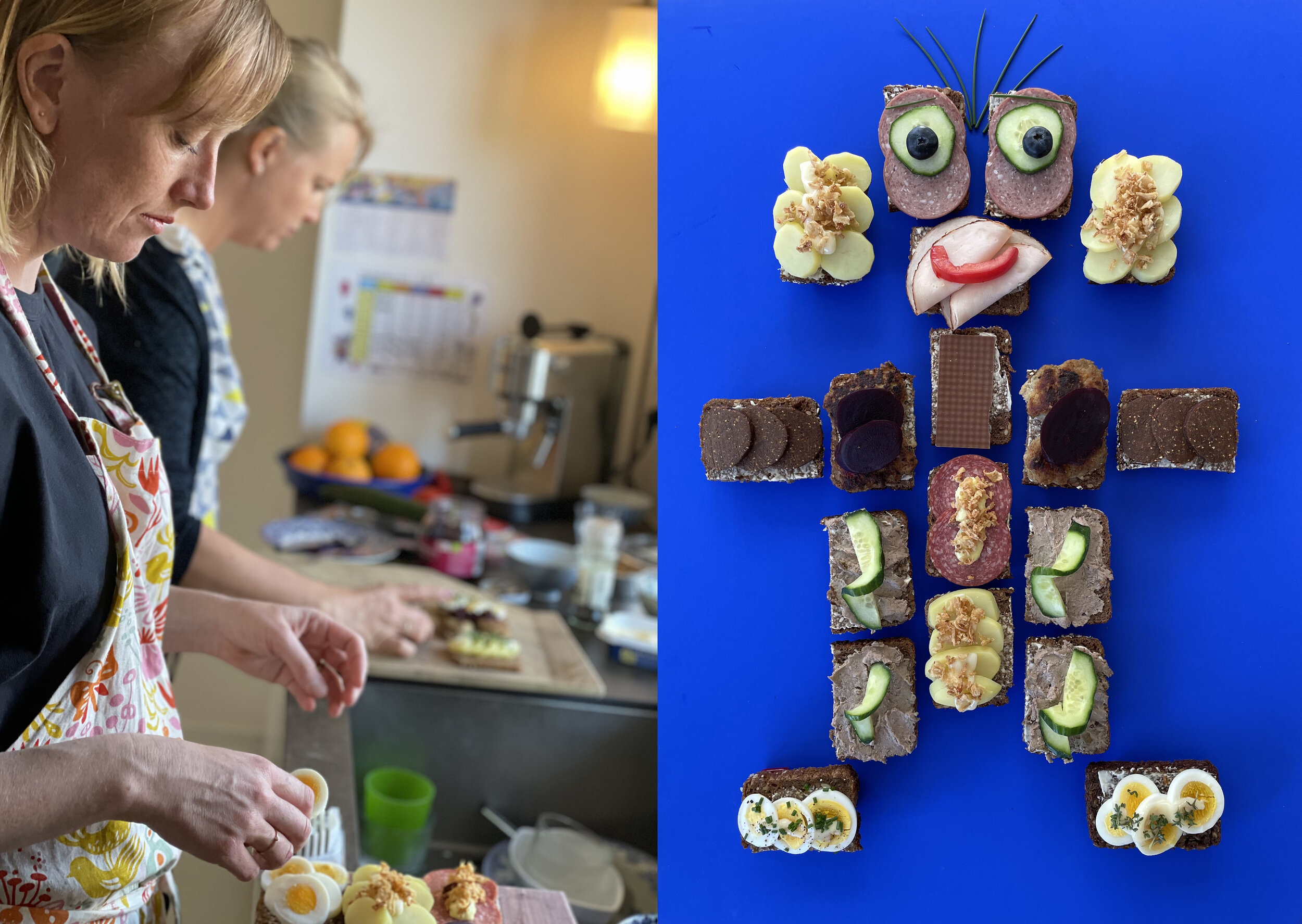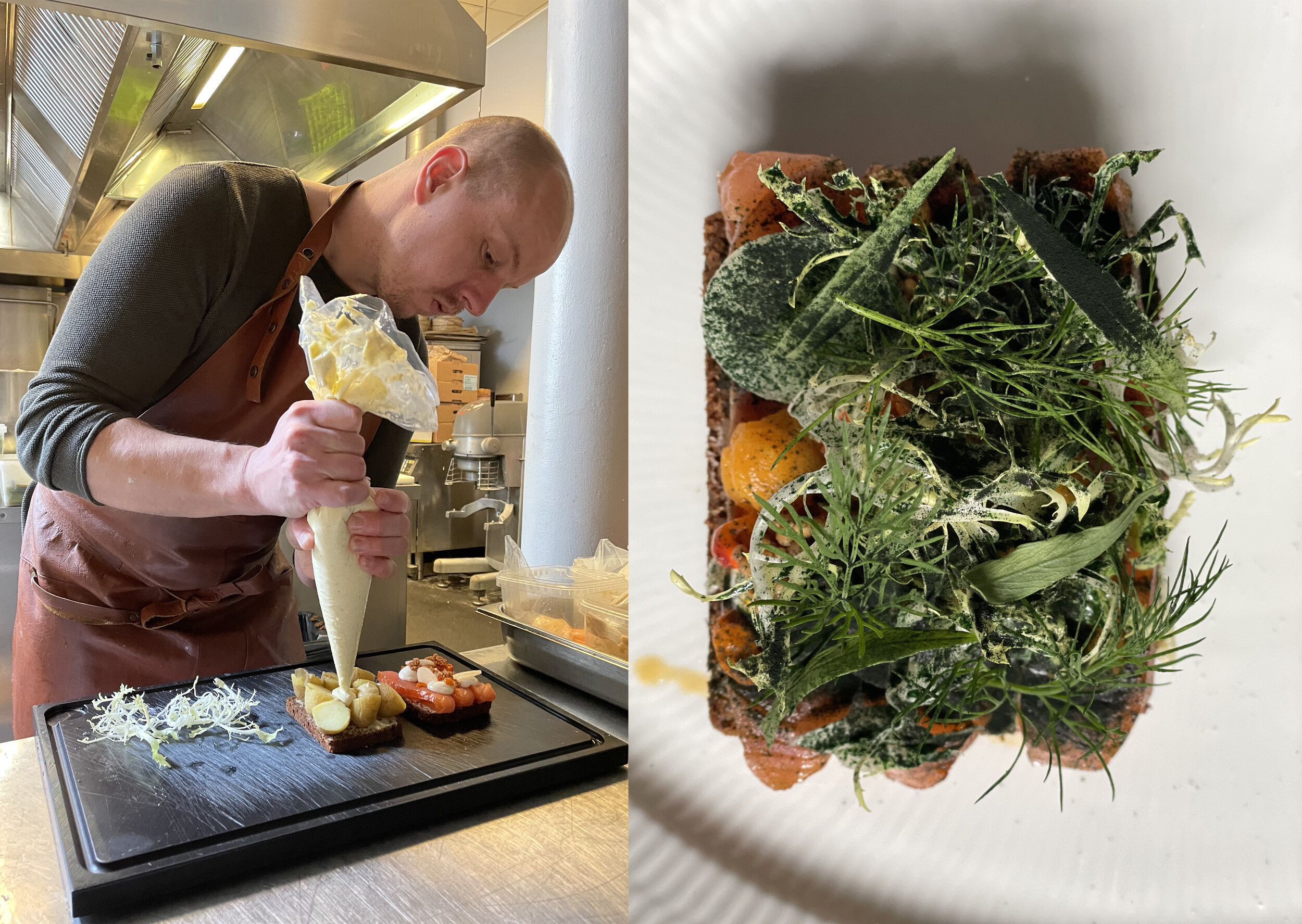Unraveling the Danish Smørrebrød
Text and Photos by Priya Mani
Adam Aamann’s take on three classics. From left: Curry spice sild with smoked oil mayo, apples and buckwheat; potatoes with pickled radishes, onions and charred leeks; pork belly with pork skin crisps and beet pickled onions.
Smørrebrød: smør, butter or fat, the application of + brød, bread
More Danish: mad is food, pålæg is food in sheets, strips and slices placed on the bread, primarily cold cuts
If smørrebrød had to be true to its name, then it was bread, fat, and some flavoring. But interestingly, the word conjures up another image in most people’s minds—a complex, layered pyramid of toppings. When did the smørrebrød become so decorated and towering, or højtbelagt as the Danes call it? To understand the smørrebrød, you have to know the rugbrødsmad, a close variety of rye bread-based open-faced sandwiches, often with names suffixed with -mad, denoting how the dish became a staple.
“In my grandfather’s youth in 1919, one would eat slæbesild—pickled herring rubbed on a slice of rye bread and lard,” says Juliette Gaarn Rasmussen of Restaurant Schønnemann. “The herring was eaten or shared at the end of the meal. It flavored the bread enough to enjoy your meal. It was like dessert, a little special. One did that with sausages, as well: a piece of bread, fat and one lice of sausage. One slice. You would pull the sausage as you ate your way through the bread."
The smørrebrød speaks of Denmark’s agrarian past. Poverty and economic inequality were a reality.
“The richer we became, the more we put on top. But first, it was just bread and butter,” says Rasmussen. Not surprisingly, one could almost trace a correlation between toppings build-up and the meteoric rise of GDP in Denmark.
***
In the summer of 2011, I visited my friend Marie on the island of Bornholm. Marie’s mother drove us from the ferry terminal, and we arrived at her traditional farmhouse past noon. After being shown my room, I was invited to come down for a meal. Marie brought out some rye bread, cheese, eggs, boiled potatoes and many condiments in bottles. Her mother brought some fresh dill and chives from the garden. I was still waiting for the plates to be set. Instead, Marie brought out some small square wooden boards and slid one over the table over to me.
“Værsgo!” she said, the Danish term to get tucking.
A little unsure of where to head from here, I waited for her to make the first move. She placed the rye on the board and put two pieces of smoked herring on it. She separated a few rings of raw onion and placed them around on the fish. Then, cracking an egg, she split the yolk and delicately placed it within a ring. A few sprigs of dill went on top.
“This is sol over Gudhjem,” she said.
The ‘sun rising over Gudhjem,’ a small finishing town not far from the house I would learn in the coming days. I thought it was avant-garde for a portion of traditional food to mimic a landscape, something modernist chefs create.
Marie’s mother offered to make me an open-faced bread too. She placed the rye on the board and put some mayonnaise on top. She gently cut the boiled potato into slices and patted them flat on the bread using her knife, and garnished it with chives, finger salt and a shake of pepper. I slowly cut my bread into bite-sized pieces and ate my way through it. It was delicious and simple.
“Does this have a name, too?” I asked.
Kartoffelmad, she said. "Potato-food"
If you live here long enough, you will learn that there are many kinds of -mad that Danes eat on their rye bread: kartoffelmad, æggemad (rye and eggs), spejepolsemad (rye and speck sausage), sildemad (rye and herring), ostemad (rye and cheese) and so on. Rye bread smeared with butter or lard and leverpostej (liver paté) is fedtmad, perhaps the simplest version, is still a popular, packed lunch among school children.
Rugbrødsmad is smørrebrød at its simplest. Most Danish families stock on these essential ingredients and put them together for a quick, everyday meal. Sine Averhoff and Naja Hansen made some classic rugbrødsmad that are everyday staples at their home.
Eating rye bread laid with toppings evolved into two cultures, one in the home as rugbrødsmad, and the other thriving as højtbelagt smørrebrød in many Copenhagen restaurants.
Sine and Naja whip up rugbrødsmad for a large family dinner with children. An interpretation of a classic kagemand (cake man) made at birthdays is always a hit with the kids.
The two have diverged considerably and thrive in their own contexts, with strict etiquette in eating them, unspoken rules of combining toppings and agreed nomenclature typical of the Scandinavian ethos. To the Danes today, the rugbrødsmad is simply not smørrebrød enough. To be a real smørrebrød, the rye needs towering layers of toppings, textures and tastes.
Classic ‘højtbelagt’ or the towering smørrebrøds, laden with cold cuts, greens and herbs are sold in delis and restaurants. Customers can point at the ones they would like and they will be served at the table.
There are many parallel developments in society that culminated in the smørrebrød culture.
The emergence of Copenhagen as the indisputable urban hotpot in the 1850s meant there was a substantial inflow of farmers and traders who came into the city with their fresh produce. At the end of the day, the farmers settled down for a drink in bars and bodegas. These places served brændtevin, a local spirit made from grain or potatoes and bread. Offering small bites was a great way to attract customers. These kitchens didn’t offer warm food, just pieces of rye bread with cold cuts, pickled fish, cured meats with some herbs.
Innovation has always been a key driver in retaining clients and attracting new ones. By the 1880s, such small smørrebrødrestaurants became popular in Copenhagen. This moment in history cannot go without the mention of Oskar Davidsen, in whose wine shop the smørrebrød attained its new, towering format. Oskar was the start of a dynasty of smørrebrød makers; his granddaughter Ida Davidsen continues to run the restaurant under her name today.
Fritz Syberg’s ‘Frokosten’ (1906) and P S Krøyer’s ‘Fire børn ved frokosten,’ Four children at lunch (1877) show the simplicity of the everyday rugbrødsmad which remains unchanged even today. Images via Wikipedia Commons.
Smørrebrød arrived in popular culture being catered in parties, gatherings and celebrations once the fashionable Restaurant Nimb, in Tivoli Gardens, put smørrebrød on its menu in 1883. By the ’40s, the variety of smørrebrøds had reached dizzying numbers, and some restaurants boasted more than 150 varieties.
Emil Bjern, who served at the Officersforeningen in Copenhagen, is credited with inventing a clever long list format to choose smørrebrøds. These lists came to be called smørrebrødsseddel, eventually becoming a moniker for endless lists.
Eating smørrebrød for lunch on the job began as a worker’s habit in the early 20th century. The decade also saw the abolition of a long lunch break and a change in worker laws. With not enough time to go back home for lunch, the tempo of the industrial age had stolen a simple luxury.
Even today, infamously, work contracts sometimes specify a 29-minute paid lunch break, but the smørrebrød has lost its luster in industrial canteens. Women joined the workforce, too, and the search for work-life balance had started. Lunch was now pieces of rye bread with chunks of last night’s dinner, smoked or pickled fish and salted meats. Warm lunch and cold supper gave way to warm food at the dinner table and cold leftovers for lunch.
The soaring necessity and popularity of the packed lunch or “madpakke” gave rise to many new industries: the invention of the smørrebrød wrappers, special slicers for cold cuts and rye bread and leverpostej or liver pate, which was creative reuse of food industry byproducts.
The wars and rigors of food rationing meant meager meals, and austerity was demanded to get through the depression that set in the 1930s. The smørrebrød stayed relevant in daily life as rugbrødsmad, but the nuanced perfection it had set out to achieve was lost in time to a society focused on nation-building. The decades after the war saw a gastronomic relief, the smørrebrød reaching new heights both literally and metaphorically.
Perhaps Ida Davidsen has done more than anyone to keep the popularity of these open-faced sandwiches from totally fading away, especially in the lean decades between the ’70s and early 2000s, a time marked by an absence of quality food and flavor.
As Denmark’s smørrebrød queen and unofficial ambassador, she took it to Hollywood, where she was invited as a young girl to set up the Danish kitchen at Scandia. She has invented and named many now classic smørrebrød, such as Dyrlægens natmad, the Veterinarian’s supper, named after Sigurd Kejlgaard, a vet and restaurant regular, or Stjerneskud, created to celebrate cosmonaut Yuri Gagarin’s stay in Copenhagen and reflect the freedom, fantasy and imagination of Davidsen’s ’60s and ’70s.
The smørrebrød industry has benefited from the democracy of taste inspired by her establishment. The smørrebrød has long served as a tourist’s delight in Denmark, and no visit to Copenhagen is complete without lunch at one of the city’s popular smørrebrød restaurants. But to emerge in sync with the times, the smørrebrød has needed reconsideration, embarking on its own journey and, like many things archaic, struggled to find its meaning in today’s New Nordic Copenhagen. Ida’s institution is for those seeking nostalgia, a bite from a time lost in the New Nordic expression.
Until 2015, the Hotel and Restaurants Skole in Copenhagen offered a three-year education program to be a smørrebrødsjomfru, literally translated as smørrebrød virgins. Now it is combined with more general education on institutional catering. The erstwhile program was particularly popular among young women who trained in the art of constructing smørrebrød, and although gender bias has eased, the term is still in use. Being a smørrebrødsjomfru continues to be a respected craft in Denmark. A couple of years ago, the title came under scrutiny for its gender bias in a rather unsavory light. Yet, the union for the somørrebrødsjomfru indeed voted to continue working with the title.
Today, leading chefs and sous chefs from all over the world who have arrived for a piece of Copenhagen’s food scene are taking to making modern smørrebrøds. It is not impossible to see Polish, Nepali and Indian men employed in high-end smørrebrød restaurants working pork belly into rullepølse or delicately placing garnishes. The smørrebrødsjomfru have their own position in the traditional Danish kitchens and canteens, and the graduates from the school open their own shops while some work in catering companies.
I had the most delightful conversations with some smørrebrødsjomfru and cooks who enlightened me on their craft. A smørrebrød is made of four elements: the bread, fat, pålæg and garnishes. The bread is the most essential element, and rye is most common.
It is a dark, dense bread slightly piquant from its sourdough starter.
A broad range of rye breads play canvas to the open-faced sandwich. Lyst rugbrød is a blend of sieved rye and wheat flours, mørkt rugbrød is richer in rye flour, softkernerrugbrød has a higher content of seeds giving it both moisture and bite. Lighter wheat breads are called franskbrød, referring to the south where whiter bread finds appeal.
The bread is sliced on a machine, and uniformity is important. The bread is smeared with fat, butter or herbed lard evenly over the edge and then slowly built in layers.
“It must not be so thick that you can taste the fat; it is to primarily impart a flavor and moisture to the pålæg. The butter and fat are ‘painted’ on the bread, all the way to the edge. When the toppings were placed, the edges of the bread must not be seen,” says Rasmussen, who, together with her husband, Thomas Gaarn Rasmussen, oversees the kitchen at Schønnemann.
All the various foods and cold cuts placed on the rye are called pålæg, meaning laid-upon. The garnishes must enhance the pålæg, not dominate it, both in taste and color. Visually, it must cover only one-third of the bread.
The toppings’ grammar strikes a balance with the salt, fat, acid and sweet. Pickles of asier, beetroots, pumpkin and capers, and garnishes like fried carrot shavings, dill, watercress offer a complete sensorial experience with texture, color and sounds.
Smørrebrød is served and eaten in an unspoken order that seems apparent to the Danes. Fish is served first—meat, followed by potatoes. The meal ends with cheese. It seems apparent to follow their landscape, starting with the ocean to enjoy the produce of the sea, moving in towards the land, cured meats of their cattle, vegetables, freshly dug out, boiled in salted water or pickled. The meal ends with cheese from their cattle.
Smørrebrød was never typically made at home except maybe at fashionable dinner parties. They would instead be ordered from a small specialty shop. A practical reason is simply the time and long list of ingredients needed to put them together. They were festmad, or party food, and at the height of their popularity in the ’40s, they were served as canapes, snitter (or small wedges) and hors d’oeuvre, a style that Davidsen cleverly adapted for the British Airways inflight service, truly making the smørrebrød popular across the west.
A small but curiously significant subculture that evolved is the mini smørrebrøds called håndmadder, typically catering to the handymen who worked from early morning until midday. These shops closed at 4pm and often had a smørrebrødsautomat, a vending machine that sold them to people who worked in late-night shifts. These are entirely unseen here in Denmark now.
The bread follows its people, and this is true as newer smørrebrød restaurants are still emerging in Copenhagen, each one determined to add their dimension to its contemporary meaning.
Adam Aamann is widely regarded as the man who put smørrebrød back on the menu. When I met him on a cold spring day during one of the COVID19 lockdowns, he seemed confident and optimistic for the smørrebrød. He says his approach to ingredients is considered and well-balanced.
“The smørrebrød had come to be a metaphor for a tsunami on a toast, the bread negligible in sight and taste,” he says. “Dressing and lettuce would drench the rest.”
In using the best ingredients and restraint in his layering, Adam achieved a sharp slice aligned with the city’s mood in 2007. Adam unlocked the smørrebrød from the shackles of traditionality, allowing for every element on the smørrebrød to be tweaked. His deconstructed approach has received international acclaim, often needed for recognition on home turf.
While Noma and the New Nordic wave put immense focus on the region’s nature and underestimated local ingredients, their techniques were essentially borrowed from the continental cuisine and interpretation was abstracted modernism. Aamann’s imprint rooted in Denmark’s native creation paved the way forward for many chefs working with smørrebrød today.
Traditional smørrebrød restaurants have benefitted from this huge revival. While they are bound by conventional offerings and the promise of nostalgia, they cannot escape the creative challenges posed by visual expression, composition and ingredient novelty in Copenhagen’s extremely competitive restaurant scene.
Schønnemann is a classic smørrebrød restaurant in Copenhagen. As a small bodega selling brændevin in the 1850s to a thriving classic joint today, it is a long lasting institution facing its daily challenges of being relevantly nostalgic and yet modern. Served here is Rejer i trængsel, 50 shrimps placed in a pyramid on a slice of wheat bread.
Visually speaking, the aesthetic of the smørrebrod has reflected its time, from the meager economics of slæbesild to the postwar tendency of disguising the true nature of foodstuffs with complicated sauces. In 1969, Dale Brown wrote in the Time-Life Series, “In the sandwich shops, smorrebrød artfully constructed from teak trays, and in their lettuce-leaf frills and cress garnishes resemble nothing so much as corsages.”
Adam’s rendition is paired down, and nuanced, and more than a decade on, smørrebrød almost looks like a textured slice of terrain. Fantasy and imagination will hopefully return afresh to the bread as we seek to look beyond the New Nordic.
Daniel Rasmussen travelled from Southern Denmark to offer a modern interpretation of smørrebrød at a pop-up in Restaurant Blomst in Copenhagen, which was instantly sold out, signaling that the smørrebrød is here to stay in its ever-evolving forms.
The smørrebrød is a living tradition and continues to be an evolving canvas for new chefs. Traditional smørrebrøds offer a perspective into their landscape, migrants and a generation of people who pioneered the cooperative movement.
As I taste my way through Denmark’s smørrebrød nouvelle, I can see that no one has been able to escape the invasion of the avocado, the fashionable new ingredient. Avocadomad is all the rage. Kartoffelmad is now upgraded with cold smoked potatoes, sprinkled with spirulina, dressed with meadow flowers and bee pollen or the ever-expanding condiment repertoire with kefir dressing, yuzu kosho and fermented truffles.
Værsgo!
Your support is invaluable to Whetstone. If you enjoyed this article and want to help us continue producing impactful food stories, please consider purchasing a magazine or an annual subscription.







